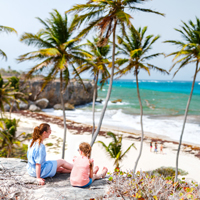Santiago de los Caballeros, the second largest city in the Dominican Republic, offers a variety of public transportation options for both locals and expats. The city’s public transportation system includes guaguas (small buses), carros publicos (shared taxis), and motoconchos (motorcycle taxis). While the city does not have a subway or train system, these modes of transportation provide a comprehensive network that covers most areas of the city. For an expat living in Santiago de los Caballeros, it is entirely possible to live comfortably without a car, relying on these public transportation options and walking. However, it’s important to understand the nuances of each system to navigate the city effectively.
Guaguas
Guaguas are the most common form of public transportation in Santiago de los Caballeros. These small buses run on fixed routes throughout the city and are a cheap and efficient way to get around. However, they can be crowded, especially during peak hours, and may not always adhere to a strict schedule. Guaguas are generally safe to use, but it’s advisable to be cautious with personal belongings due to the crowded nature of the buses. The cost of a ride is usually around 25 Dominican pesos, making it an affordable option for daily commuting.
Carros Publicos
Carros publicos, or public cars, are shared taxis that operate on fixed routes. They are a step up from guaguas in terms of comfort, as they are usually less crowded. However, they are also slightly more expensive, with fares typically ranging from 50 to 100 Dominican pesos. Carros publicos are considered safe, but as with any form of public transportation, it’s important to be aware of your surroundings. They operate throughout the day and into the evening, making them a reliable option for getting around the city.
Motoconchos
Motoconchos are motorcycle taxis that provide a quick and convenient way to get around Santiago de los Caballeros. They are ideal for short distances and can navigate through traffic more easily than buses or cars. However, they are also the riskiest form of public transportation due to the inherent dangers of motorcycle travel. Helmets are not always provided, and traffic rules are not always strictly followed. Fares vary depending on the distance, but are generally affordable. It’s recommended to negotiate the fare before starting the ride.
In conclusion, Santiago de los Caballeros offers a variety of public transportation options that make it possible to live comfortably without a car. However, each mode of transportation comes with its own set of considerations in terms of cost, safety, and convenience. As an expat, it’s important to familiarize yourself with these systems to navigate the city effectively. With a bit of practice and local knowledge, getting around Santiago de los Caballeros can be a breeze.


